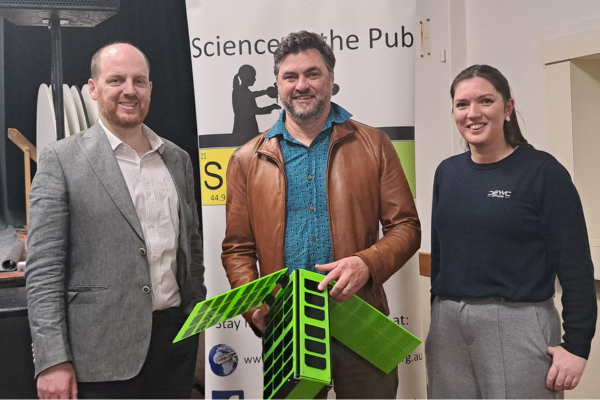Science in the Pub Adelaide is a fantastic local initiative with a simple but powerful mission: to bring science out of the lab and into a casual pub setting for everyone to discuss and learn.
It’s a monthly gathering that brings together a panel of experts and critical thinkers from all backgrounds to explore hot topics in science in an informal, accessible way. On the evening of 27 June, my colleagues Dr Andrew Barton, Emily Ahern, and I had the honour of presenting as that panel of experts.
We took the stage at the Adelaide Irish Club to present our session, From Atoms to Asteroids: Innovations in Space and Time, to a packed house of over 150 people ready to explore how our work is shaping the future.
 (L to R) SmartSat Research Program Manager, Dr Andrew Barton; Senior Earth Observation Specialist, Fabrice Marre; and PhD student Emily Ahern at Science in the Pub
(L to R) SmartSat Research Program Manager, Dr Andrew Barton; Senior Earth Observation Specialist, Fabrice Marre; and PhD student Emily Ahern at Science in the Pub
I kicked off the session with a deep dive into how we use Earth Observation to monitor Australia’s environment. I explained that satellites are our essential tool, acting as our eyes in the sky to measure, monitor, and track our planet’s systems.
Using their ability to see light invisible to the human eye, we can rewind five decades of history with the Landsat archive or watch our entire continent ‘breathe’ with the seasons. I emphasised that the real magic happens when we combine this satellite data with other sources into powerful models, creating simple, actionable insights to help manage Australia’s pressing challenges, from tracking bushfires to monitoring the health of our vegetation.
Next, my colleague Andrew Barton shifted our focus from our planet to the cosmos with his presentation, Space Mining for Australia. He outlined the emerging field of extracting resources from asteroids and moons, assessing both the commercial realities and the significant progress being made by government missions.
Andrew presented a core strategy for the future: minimising costs by mining resources in space, for use in space. This creates a new value chain of in-orbit depots and factories, and Andrew concluded by challenging Australia to leverage its world-class terrestrial mining expertise to secure a leading role in this next frontier.
To conclude our session, SmartSat PhD candidate Emily Ahern brought the focus down to the quantum level with her work on Atomic Clocks. She explained the fundamental role these devices play in our daily lives, providing the precise timing essential for everything from GNSS to our electrical grids.
Highlighting the vulnerabilities of our current systems, Emily presented her PhD research as a direct solution: a compact, low-power, next-generation optical atomic clock. Her work aims to create more robust and sovereign navigation systems that can maintain accuracy even when signals are disrupted, addressing a critical need for Australia.
The evening was a fantastic success. We were thrilled to present to an enthusiastic audience, and the sheer number of thoughtful questions sparked a fantastic and engaging discussion. It was a wonderful opportunity for us to share our passion for space, science and innovation and to connect with a community just as excited as we are about the future.
Fabrice Marre
Senior Earth Observation Specialist